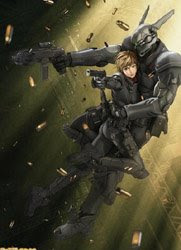 Series Overview Series OverviewDVD Info Trailer Rating: Overall= D+ Story = D Video = C Audio = C |
Journal
After a long war with the Republic of Frost, the Empire abruptly signs a cease-fire, ending the war. Three years later, the Empire is in ruins with starvation and plague. Former soldiers have become bandits. Former Anti-Tank Trooper, Randel Orlando, unexpectedly runs into and joins the Pumpkin Scissors platoon, an Imperial Army relief effort led by Alice L. Malvin to restore order to the war-torn Empire. (Source: ANN)
The first few episodes of Pumpkin Scissors seem promising. It takes place in the aftermath of a war where a small band of soldiers is trying to protect the commoners from the corruption and abuse of the upper class. The group includes a gentle-giant with a mysterious origin who turns into a ruthless killer whenever he lights is blue lantern. There is a driven noble woman who goes against her family's wishes in order to work for the common people. There are all kinds of ironic characters, relatable themes, and intriguing mysteries that should have made for a compelling series. But it ends up either not cashing in on this potential, or cashing in too much, or waiting to cash in until just before the series ends.
Let's start with the "Anti-Tank Trooper" Randel Orlando. In the beginning, this is the character that makes you sit back and say, "This is going to be such an awesome show." He's huge with a scarred face and lives under a bridge with the other homeless people. He's kind with a quiet, gentle demeanor; but when he lights up the lantern that hangs on his hip, his eyes go blank, he pulls out his gun and nothing -- not even a tank -- can stop him from taking out his target. Power, compassion, and mystery all come together with this guy. So what happened?
First of all, the show never delves into Orlando's past. We learn that there is this scientist lady who apparently made him the way he is. We also learn the reason behind why he was created -- that being to wield the large anti-tank gun that can only be affective against a tank at close range; thus the person using the gun had to have no fear of death. But we never learn the specific past of Orlando himself. Where did he originally come from? Why was he specifically chosen to be an Anti-Tank Trooper? What kind of brain washing had to take place to make that possible? And of course, I couldn't help but think that there was a greater conspiracy behind it all. For instance, why would Orlando be sent to the Pumpkin Scissors unit in the first place? There had to be a story behind that, but we never learn what it is.
The other thing about Orlando is that he lights his craziness-lantern way too much. In every single episode for most of the series, that is how the Pumpkin Scissors unit gets out of a jam. That tank coming after you? Light the lantern. Guys coming at you with guns? Light the lantern. Kitten stuck in a tree? Light the lantern. After a while it lost it's meaning and intensity because it became predictable and seemed like overkill for most of the situations.
The other character that has a lot of potential is Alice. She is just the opposite of Orlando. She is outgoing and aggressive, but lives with her well-to-do noble family. And just like Orlando, she has her own set of mysteries that never pan out. These mysteries mostly have to do with her fiance.. what's-his-name. He is all suave and easy-going, but he is obviously just using her for some scheme of his own, but we never lean what that is.
I think that overall the reason this show is such a disappointment is because I was expecting all this character development and unraveling conspiracies over a long story. But about three quarters or of the show involve stand alone episodes that do not contribute to any grander story arc. So you never get the feeling of the story progressing or the scope of the story growing. And when we do finally get a string of episodes that show potential for a larger story, the series suddenly ends and we wind up with all kinds of loose strings.
The animation does not even make the show worth watching. The first few episodes have some quality animation, but after that it ranges from average to poor.
So I can not recommend this show at all. It has a lot of poential but nothing develops to any satisfactory degree.














 [ UPDATE:
[ UPDATE:  Tales of the Black Freighter was a "comic within a comic" in the original Watchmen graphic novel. In the book, a boy hangs out at a news stand reading this comic and talking to the stand's owner; all while the world is pretty much falling apart in the background.
Tales of the Black Freighter was a "comic within a comic" in the original Watchmen graphic novel. In the book, a boy hangs out at a news stand reading this comic and talking to the stand's owner; all while the world is pretty much falling apart in the background.




